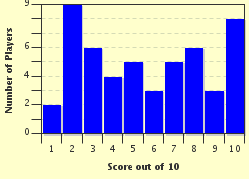Quiz Answer Key and Fun Facts
1. What is the name of the process by which proteins are made?
2. The individual units of proteins are called amino acids. What is the term for short chains of these amino acids?
3. To make proteins, you need a starting template. What molecule acts as the template for protein synthesis?
4. Protein synthesis also requires "machinery" to produce the protein. Which part of the cell acts as this machine?
5. The template is read in groups of three called codons. Given the number of possible bases, how many total possible codons are there?
6. How many total amino acids are coded for by the different codons?
7. No matter what sequence of amino acids a protein contains, one amino acid in particular is commonly first in line. What is the full name of this amino acid, represented by the letter M and the abbreviation Met?
8. When amino acids bond in protein synthesis, a certain common molecule is left over in the process. What is this essential molecule, found in you, me and almost everywhere on Earth?
9. When synthesis is finished, a stop codon tells the cell the protein is complete. In humans, there are three different types of stop codons with colorful names. Which of these is NOT one of the stop codons?
10. Before the protein can be used, it has to be folded into the right shape. Which of these terms does NOT describe a common shape that proteins take?
Source: Author
M00se88
This quiz was reviewed by FunTrivia editor
rossian before going online.
Any errors found in FunTrivia content are routinely corrected through our feedback system.

